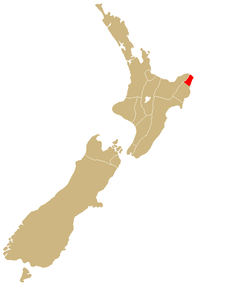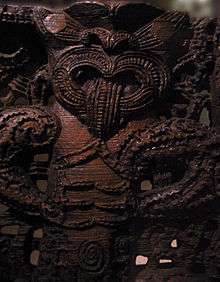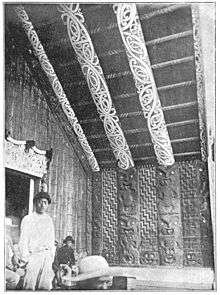Ngāti Porou
| Ngāti Porou | |
| Iwi of New Zealand | |
|---|---|
 | |
| Rohe (region) | East Cape and Gisborne region |
| Waka (canoe) | Horouta |
| Population | 71,910 |
| Website | www |
Ngāti Porou is a Māori iwi traditionally located in the East Cape and Gisborne regions of the North Island of New Zealand. Ngāti Porou has the second-largest affiliation of any iwi in New Zealand, with 71,910 registered members in 2006.[1] The traditional tribal boundary of Ngāti Porou extends from Pōtikirua in the north to Te Toka-a-Taiau (a rock that used to sit in the mouth of Gisborne harbour) in the south.
Geographical landmarks
Mt Hikurangi features prominently in Ngāti Porou traditions as a symbol of endurance and strength, and holds tapu status. In these traditions, Hikurangi is often personified. Ngāti Porou traditions indicate that Hikurangi was the first point to surface when Māui fished up the North Island from beneath the ocean. His canoe, the Nuku-tai-memeha, is said to have been wrecked there. The Waiapu River also features in Ngāti Porou traditions.
History

Early history
Ngāti Porou takes its name from the ancestor Porourangi (also known as Porou Ariki[2]). He was a direct descendant of Toi-kai-rākau, who is also regarded as a prominent ancestor of Ngāti Porou. Other ancestors include Māui, accredited in oral tradition with raising the North Island from the sea, and Paikea, the whale rider. Although Ngāti Porou claim the Nukutaimemeha as their foundation canoe, many Ngāti Porou ancestors arrived on different canoes, including Horouta, Tākitimu and Tereanini. The descendants of Porourangi and Toi formed groups that spread across the East Cape through conquest and through strategic marriage alliances.
Associations with other iwi also arise through direct descent from Ngāti Porou ancestors:
- Kahungunu, descending from Ueroa, second son of Porourangi, is the founding ancestor of Ngāti Kahungunu, who occupy the region south of the Ngāti Porou tribal boundaries.
- Taua, descended from Kahungunu, is a prominent ancestor in Te Whānau-ā-Apanui genealogy.
- Ngāti Raukawa and the Tainui iwi have association through Rongomaianiwaniwa, daughter of Porourangi, and the marriage of the ancestress Māhinaarangi to Tūrongo.
- Ngai Tahu traditions also indicate descent from both Porourangi and from Tahupōtiki, younger-brother to the latter.
19th century history
The early 19th century saw Ngāti Porou in conflict with Ngā Puhi during the latter's campaign of warfare throughout the North Island. This period also saw the introduction of Christianity to the region, which led to a period of relative calm and cultural development. Ngāti Porou chiefs were also signatories to the Treaty of Waitangi in 1840. Ngāti Porou experienced substantial economic growth during the 1850s.
The Hauhau Conflict
During the 1860s, the Pai Mārire religious movement spread through the North Island, and eventually came into conflict with the New Zealand Government. From 1865–1870, a civil war emerged within Ngāti Porou, between Pai Mārire converts seeking the creation of an independent Māori state (supported by Pai Mārire from other regions) and other Ngāti Porou advocating tribal sovereignty and independence. This conflict is generally viewed as part of the East Cape War.
Modern history
Ngāti Porou once again enjoyed peace and economic prosperity during the late 19th century. The 1890s saw the emergence of Sir Āpirana Ngata, who contributed greatly to the revitalisation of the Māori people. During the early 20th century, the population of Ngāti Porou increased substantially. They were active in their participation in both World Wars. After World War II, large numbers of Ngāti Porou began emigrating from traditional tribal lands and moving into larger urban areas, in a trend reflected throughout New Zealand. A large portion of the tribal population now lives in Auckland and Wellington.
Ngāti Porou today
Administration
Te Rūnanga o Ngāti Porou, established in 1987, is the tribal authority for the iwi. The Rūnanga aims to maintain the financial, physical and spiritual assets of Ngāti Porou. It is organised into three branches: Whanau Hapu Development, Economic Development and Corporate Services.[4]
Well-known Ngati Porou
- Sir Āpirana Ngata
- George Nepia
- Te Moana Nui a Kiwa Ngarimu VC
- Witi Ihimaera
- Parekura Horomia
- John Tamihere (politician)
- Moana Jackson
- Sofia Minson (artist)
- Wynton Rufer
- Georgina Beyer
- Robyn Kahukiwa
- William Singe
- Alex Aiono
Radio Ngāti Porou
Radio Ngāti Porou is the official station of Ngāti Porou. It is based in Ruatoria and broadcasts on 89.3 FM in Tikitiki, 90.5 FM at Tolaga Bay, 93.3 FM in Gisborne, 98.1 FM in Ruatoria, and 105.3 FM at Hicks Bay.[5][6]
Notes
- ↑ "2006 Census – QuickStats About Māori (revised)". Statistics New Zealand. 2007-04-04. Archived from the original on 2007-09-28. Retrieved 2007-05-25.
- ↑ Ngata, Apirana Turupa; Te Hurinui, Pei (1970). Nga moteatea: he maramara rere no nga waka maha, he mea kohikohi na A.T. Ngata; na Pei Te Hurinui i whakapakeha. 3. The Polynesian Society. p. 323. Retrieved 2015-05-26.
That line traces out to Porou-rangi, whose (original?) name was Porou-ariki te mata-tara-a-whare, and Te Tuhi-marei-kura of Rauru.
- ↑ Reedy, Tamati Muturangi (24 September 2011). "Ngāti Porou: Porourangi whare, Waiomatatini". Te Ara - the Encyclopedia of New Zealand. Wellington, New Zealand: Manatū Taonga | Ministry for Culture and Heritage. Retrieved 12 May 2012.
- ↑ Te Rūnanga o Ngāti Porou mission statement
- ↑ "Radio Ngati Porou". Radio Ngati Porou. RNP. Retrieved 14 June 2015.
- ↑ "Iwi Radio Coverage" (PDF). maorimedia.co.nz. Māori Media Network. 2007. Retrieved 14 June 2015.
References
- Mahuika AT (1993-05-25). "History: Porourangi & Ngāti Porou". Te Rūnanga o Ngāti Porou. Archived from the original on 2006-12-11. Retrieved 2007-04-10.
- Reedy, Tamati Muturangi (2006-12-21). "Ngāti Porou". Te Ara – the Encyclopedia of New Zealand. Retrieved 2007-04-10.
